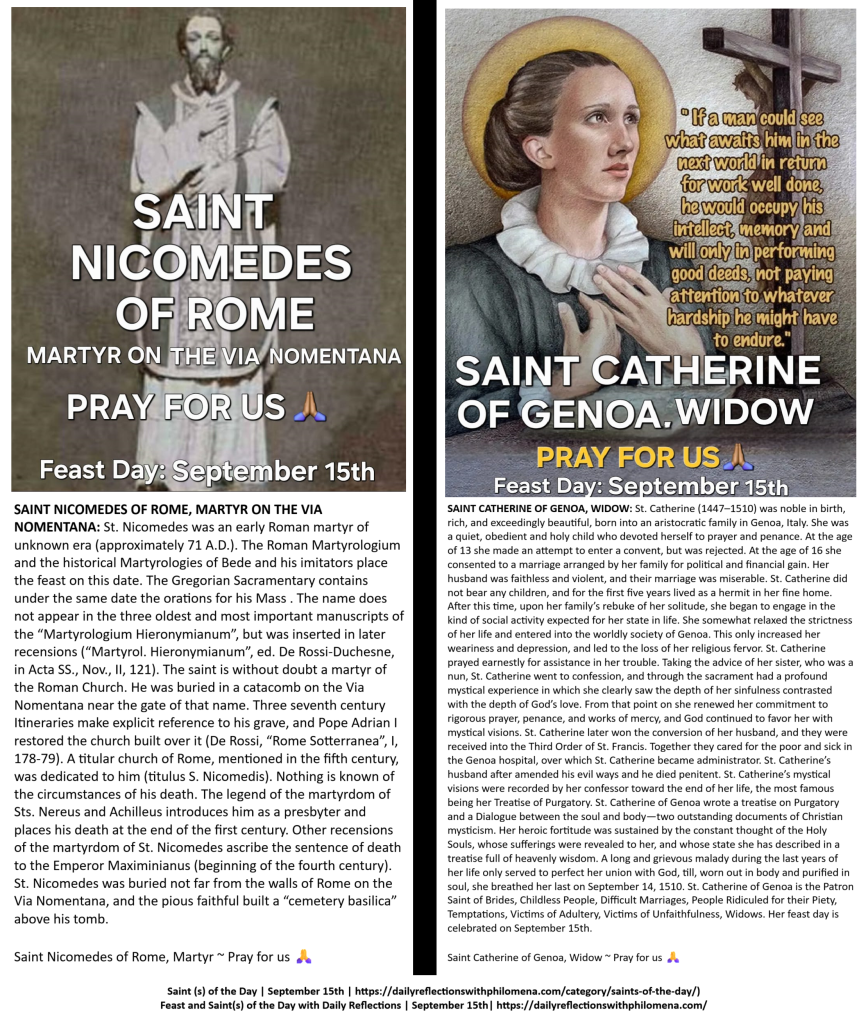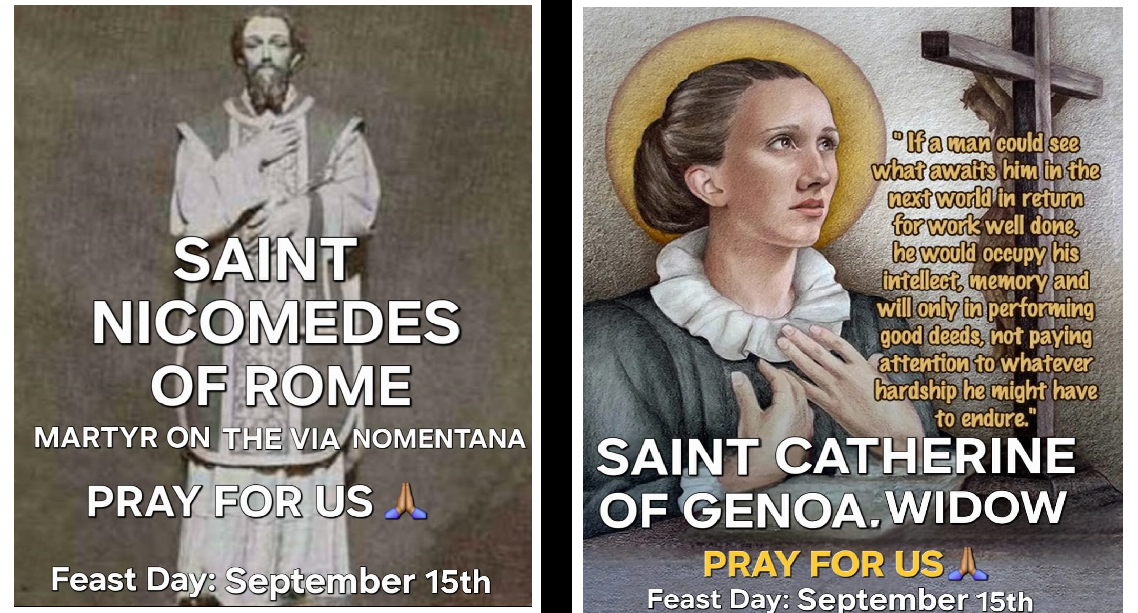
MEMORIAL OF OUR LADY OF SORROWS ~ FEAST DAY: SEPTEMBER 15TH: Today, we celebrate the Memorial of Our Lady of Sorrows. Through the intercession of our Blessed Mother Mary and the Saints on this feast day, we humbly pray for those seeking for the fruit of the womb, we pray for difficult marriages, for all widows and widowers, for peace, love, and unity in our marriages, our families and our world. We pray for the sick and dying, especially those who are mentally and physically ill, and those suffering from cancers and other terminal diseases. We pray for the souls in Purgatory and the repose of the souls of the faithful departed. We pray for the poor and needy. And we continue to pray for our Holy Father, the Bishops, the Clergy, for vocations to the priesthood and religious life, for the Church, for persecuted christians, for the conversion of sinners, and Christians all over the world…. Amen🙏
OUR LADY OF SORROWS: The feast of Our Lady’s Sorrows (Our Lady’s Seven Sorrows or Mater Dolorosa – Mother of Sorrows) has its origin in Christian devotion which finds it fitting to associate her with the Passion of her Son.This feast is celebrated on the September 15, the day after the feast of the Holy Cross to show the close connection between Jesus’ Passion and Mary’s Sorrows. The title, Our Lady of Sorrows, given to our Blessed Mother focuses on her intense suffering and grief during the passion and death of our Lord. This feast dates back to the 11th and 12th centuries. Devotion to the Seven Sorrows of Our Lady has its roots in Sacred Scripture and in Christian piety, which always associates the Blessed Mother with her suffering Son and became widespread in the Church around the 14th century.
The feast of Our Lady of Sorrows commemorates the seven great sorrows which Mary lived in relation to Her Son, as they are recorded in the Gospels or through Tradition. Today we are invited to reflect on Mary’s deep suffering: As Mary stood at the foot of the Cross on which Jesus hung, the sword of sorrow Simeon had foretold pierced her soul. Jesus is ‘destined to be a sign that is rejected’ and, as for Mary, ‘a sword will pierce your own soul too’. It was revealed to St. Bridget of Sweden (1303-1373) that devotion to Our Lady’s Seven Sorrows would bring great graces. Mary, in a unique way, willingly suffered alongside her Divine Son as he gave his life to save the world, and she felt the bitterness of his passion as only a mother can. This devotion is especially remembered during September, the Month of Our Lady of Sorrows, and during the season of Lent.
Below are the seven sorrows of Mary:
- At the prophecy of Simeon (Luke 2:25-35): “You yourself shall be pierced with a sword – so that the thoughts of many hearts may be laid bare.”
- At the flight into Egypt (Matthew 2:13-15): “Get up, take the child and his mother, and flee to Egypt.”
3.Having lost the Holy Child Jesus at Jerusalem for three days (Luke 2:41-50): “You see that your father and I have been searching for you in sorrow.” - Mary meets Jesus on His way to Calvary (Luke 23:27-31; John 19:17)
- Crucifixion and Death of Jesus (John 19:25-30): Standing at the foot of the Cross; “Near the cross of Jesus there stood His mother.”
- The body of Jesus being taken from the Cross (Psalm 130; Luke 23:50-54; John 19:31-37)
- At the burial of Jesus (Isaiah 53:8; Luke 23:50-56; John 19:38-42; Mark 15:40-47)
Prior to the Second Vatican Council, there were two feasts devoted to the sorrows of Mary. The first feast was insitituted in Cologne in 1413 as an expiation for the sins of the iconoclast Hussites. The second is attributed to the Servite order whose principal devotion are the Seven Sorrows. It was institued in 1668, though the devotion had been in existence since 1239 – five years after the founding of the order. Today’s feast was introduced by the Servites in order to intensify devotion to Our Lady’s Sorrows. In 1817 Pius VII—suffering grievously in exile but finally liberated by Mary’s intercession—extended the feast to the universal Church. The feast was especially promoted by the Cistercians and the Servites, so much so that in the 14th and 15th centuries it was widely celebrated throughout the Catholic Church. In 1482 the feast was added to the Missal under the title of “Our Lady of Compassion.” Pope Benedict XIII added it to the Roman Calenda in 1727 on the Friday before Palm Sunday. In 1913, Pope Pius X fixed the date on September 15. The title “Our Lady of Sorrows” focuses on Mary’s intense suffering during the passion and death of Christ. ” The Seven Dolors,” the title by which it was celebrated in the 17th century, referred to the seven swords that pierced the Heart of Mary. This feast is dedicated to the spiritual martyrdom of Mary, Mother of God, and her compassion with the sufferings of her Divine Son, Jesus. In her suffering as co-redeemer, she reminds us of the tremendous evil of sin and shows us the way of true repentance. May the numerous tears of the Mother of God be conducive to our salvation; with which tears Thou, O God, art able to wash away the sins of the whole world. By offering her Son for us, she became our Mother and we became her children. Patron Saint of people named Dolores, Dolais, Deloris, Dolorita, Maria Dolorosa, Pia, and Pieta.
The Memorare: Remember, O most gracious Virgin Mary, that never was it known that anyone who fled to thy protection, implored thy help, or sought thine intercession was left unaided. Inspired by this confidence, I fly unto thee, O Virgin of virgins, my mother; to thee do I come, before thee I stand, sinful and sorrowful. O Mother of the Word Incarnate, despise not my petitions, but in thy mercy hear and answer me. Amen 🙏
Hail Mary, full of grace, the Lord is with you; blessed are you among women, and blessed is the fruit of your womb, Jesus. Holy Mary, Mother of God, pray for us sinners now and at the hour of our death. Amen.🙏
OTHER SAINTS OF THE DAY: SAINT NICOMEDES OF ROME, MARTYR ON THE VIA NOMENTANA AND ST CATHERINE OF GENOA, WIDOW – FEAST DAY~ SEPTEMBER 15TH
On this Feast of Our Lady of Sorrows, we also celebrate the Memorial of Saint Nicomedes of Rome, Martyr of the Via Nomentana and Saint Catherine of Genoa, Widow.
SAINT NICOMEDES OF ROME, MARTYR ON THE VIA NOMENTANA: St. Nicomedes was an early Roman martyr of unknown era (approximately 71 A.D.). The Roman Martyrologium and the historical Martyrologies of Bede and his imitators place the feast on this date. The Gregorian Sacramentary contains under the same date the orations for his Mass . The name does not appear in the three oldest and most important manuscripts of the “Martyrologium Hieronymianum”, but was inserted in later recensions (“Martyrol. Hieronymianum”, ed. De Rossi-Duchesne, in Acta SS., Nov., II, 121). The saint is without doubt a martyr of the Roman Church. He was buried in a catacomb on the Via Nomentana near the gate of that name. Three seventh century Itineraries make explicit reference to his grave, and Pope Adrian I restored the church built over it (De Rossi, “Rome Sotterranea”, I, 178-79). A titular church of Rome, mentioned in the fifth century, was dedicated to him (titulus S. Nicomedis). Nothing is known of the circumstances of his death. The legend of the martyrdom of Sts. Nereus and Achilleus introduces him as a presbyter and places his death at the end of the first century. Other recensions of the martyrdom of St. Nicomedes ascribe the sentence of death to the Emperor Maximinianus (beginning of the fourth century). St. Nicomedes was buried not far from the walls of Rome on the Via Nomentana, and the pious faithful built a “cemetery basilica” above his tomb.
Saint Nicomedes of Rome, Martyr ~ Pray for us 🙏
SAINT CATHERINE OF GENOA, WIDOW: St. Catherine (1447–1510) was noble in birth, rich, and exceedingly beautiful, born into an aristocratic family in Genoa, Italy. She was a quiet, obedient and holy child who devoted herself to prayer and penance. At the age of 13 she made an attempt to enter a convent, but was rejected. At the age of 16 she consented to a marriage arranged by her family for political and financial gain. Her husband was faithless and violent, and their marriage was miserable. St. Catherine did not bear any children, and for the first five years lived as a hermit in her fine home. After this time, upon her family’s rebuke of her solitude, she began to engage in the kind of social activity expected for her state in life. She somewhat relaxed the strictness of her life and entered into the worldly society of Genoa. This only increased her weariness and depression, and led to the loss of her religious fervor. St. Catherine prayed earnestly for assistance in her trouble. Taking the advice of her sister, who was a nun, St. Catherine went to confession, and through the sacrament had a profound mystical experience in which she clearly saw the depth of her sinfulness contrasted with the depth of God’s love. From that point on she renewed her commitment to rigorous prayer, penance, and works of mercy, and God continued to favor her with mystical visions. St. Catherine later won the conversion of her husband, and they were received into the Third Order of St. Francis. Together they cared for the poor and sick in the Genoa hospital, over which St. Catherine became administrator. St. Catherine’s husband after amended his evil ways and he died penitent. St. Catherine’s mystical visions were recorded by her confessor toward the end of her life, the most famous being her Treatise of Purgatory. St. Catherine of Genoa wrote a treatise on Purgatory and a Dialogue between the soul and body—two outstanding documents of Christian mysticism. Her heroic fortitude was sustained by the constant thought of the Holy Souls, whose sufferings were revealed to her, and whose state she has described in a treatise full of heavenly wisdom. A long and grievous malady during the last years of her life only served to perfect her union with God, till, worn out in body and purified in soul, she breathed her last on September 14, 1510. St. Catherine of Genoa is the Patron Saint of Brides, Childless People, Difficult Marriages, People Ridiculed for their Piety, Temptations, Victims of Adultery, Victims of Unfaithfulness, Widows. Her feast day is celebrated on September 15th.
Saint Catherine of Genoa, Widow ~ Pray for us 🙏
